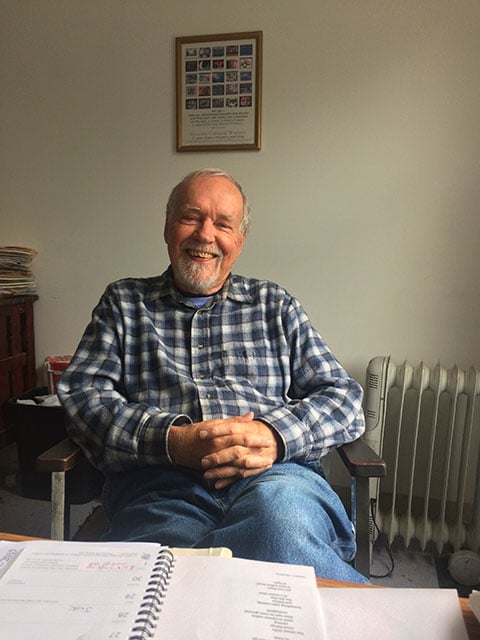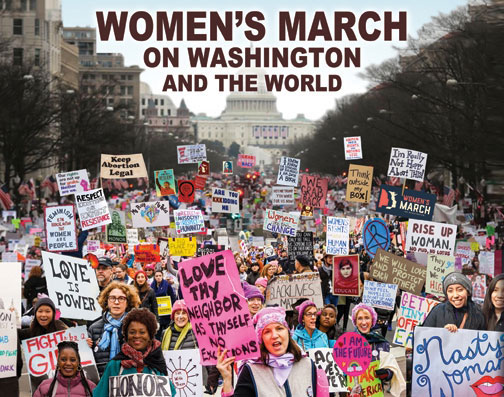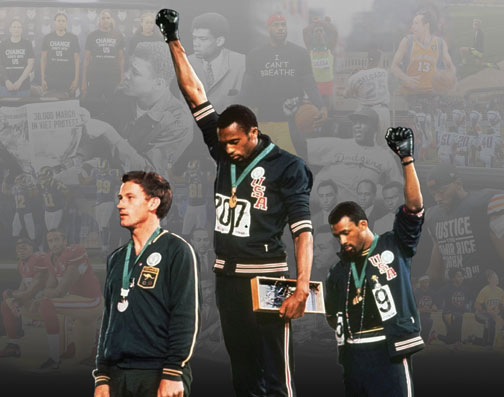
Every morning, 15,000 people wake up to look at peace.
Their days are not measured by calendars of vintage automobiles or Hollywood stars, but by images and annotations of peace and progressive historical events. The 2018 Syracuse Cultural Workers Peace Calendar has been “giving voice to resistance” since 1971. Next year marks the 47th edition of the calendar, which has a rich history of awakening viewers to images of nonviolence and justice — and also offering 200 annotations of the anniversaries of progressive events and unjust actions. In that sense, it represents a daily companion piece to Howard Zinn’s A People’s History of the United States.
The first Peace Calendar was created in 1971 under the supervision of Dik Cool and the Syracuse Peace Council, one of the oldest peace groups in the United States. Through times of thin budgets and organizational change, it eventually moved over to be produced annually by the Syracuse Cultural Workers, which currently has a staff of 11 full-time employees. Syracuse Cultural Workers offers items promoting peace from a two-story house in Syracuse, New York.
 Dik Cool of the Syracuse Cultural Workers has overseen the production of the Peace Calendar for 47 years. (Photo: Syracuse Cultural Workers)There are a number of goals for the Peace Calendar each year. They include educating people every day about the history of advocacy and the peace movement, as well as providing progressive counterpoints to mainstream holidays that symbolize oppression (for example, Indigenous Peoples’ Day replaces Columbus Day). The calendar also honors artists who celebrate peace and justice with a venue for their works. Given that the calendars are bought and displayed by people around the world, they also symbolize the interconnectedness of those striving for peace.
Dik Cool of the Syracuse Cultural Workers has overseen the production of the Peace Calendar for 47 years. (Photo: Syracuse Cultural Workers)There are a number of goals for the Peace Calendar each year. They include educating people every day about the history of advocacy and the peace movement, as well as providing progressive counterpoints to mainstream holidays that symbolize oppression (for example, Indigenous Peoples’ Day replaces Columbus Day). The calendar also honors artists who celebrate peace and justice with a venue for their works. Given that the calendars are bought and displayed by people around the world, they also symbolize the interconnectedness of those striving for peace.
“I think the calendar affects people in a lot of different ways,” Cool, who still oversees the calendar each year as part of an eight-person committee, told Truthout. “A few years back we commemorated the Stonewall riots one month, and it was amazing to me how many people were moved to see the event celebrated and let us know. A key accomplishment to me is that it reinforces people’s values and inspires those who are not advocates to action. This is in the context of the calendar creating a sense of alternative community. Wherever you see the calendar around the world, you know that you are part of it.”
Cool forwarded Truthout a 1996 history of the wall calendar up to that time. In the nine-page document, there is telling statement from the 1992 calendar called “What Syracuse Workers Believe”:
We are responsible for creating a culture in our own image. Our work is not simply to expose the evils, display our disrespect for greed and violence, refuse to cooperate with a consumerist culture. We need to build a culture of change. We need political art that is visionary, visionary art that is political … We are a vast community of resisters and believers, artists and activists. We live our lives on next to nothing in order to do work that we can believe in. Though we are renewed collectively at political rallies, music festivals, solstice rituals, what is it that sustains us when the candles are out and the crowd dispersed? What is it that keeps us fueled for the fight in our day-to-dayness? Art reflects our visions back to us, bears witness to the triumph of our sensibilities, helps us remember what we need to remember in order to survive. Art and activism are like yin and yang, light and dark — one is nothing without the other.
 The calendar’s March photograph commemorates the 2017 Women’s March on Washington and the sister marches that took place across the world. (Photo: Katie Bordner)Cool asserts that the calendar offers an alternative to the capitalist system of collecting consumer objects and being judged by the accumulation of wealth. “Showing people that there are peace advocates and a history of peace actions around the world gets people motivated and involved,” he told Truthout. “The calendars help people to feel empowered through a sense of connectedness, of community.”
The calendar’s March photograph commemorates the 2017 Women’s March on Washington and the sister marches that took place across the world. (Photo: Katie Bordner)Cool asserts that the calendar offers an alternative to the capitalist system of collecting consumer objects and being judged by the accumulation of wealth. “Showing people that there are peace advocates and a history of peace actions around the world gets people motivated and involved,” he told Truthout. “The calendars help people to feel empowered through a sense of connectedness, of community.”
It’s appropriate that Cool played a role in launching the calendar, given that he spent two years in federal prison for resisting the Vietnam War draft. As he mentioned his long encounter with the mass incarceration system, he said that he had no regrets. “I met a lot of people who I never otherwise would have met. It helped me to become even more radicalized.”
The 1996 history of the Peace Calendar emphasizes the important ways in which artists and activists are enriched by having their works and words enter so many households:
The November artwork [of the 1975 calendar] — three paintings depicting prison life — was accompanied by a particularly moving artist’s statement that drives home the importance of art in nourishing the human spirit in the face of daunting realities. Joel Gaines, who was at the time an inmate serving 20 years to life at Auburn (NY) state prison, and who taught himself to draw and paint during his incarceration, wrote: “I have been saved through my pigments, brushes and canvas… Through art I have found beauty in squalor and homely faces attractive as beautiful ones. In painting I have found beauty and a new life.” It has been an unflagging belief in that power of art — to transform, heal and sustain — that has kept the calendar going all these years.
 For October, this collage honors Tommie Smith and John Carlos’ Black Power salute at the 1968 Olympics that instantly became an iconic image. (Image: Syracuse Cultural Workers)Katie Bordner of Pittsburgh, a teacher and photographer, expressed her pride in having her powerful photograph of the 2017 Women’s March chosen for the March 2018 calendar. “I was very excited to be be part of the project. The Syracuse Worker’s Collective sought me out after finding my photos of the Women’s March on Flickr,” she told Truthout. “I was really honored. I attended the march because I needed to feel hopeful.”
For October, this collage honors Tommie Smith and John Carlos’ Black Power salute at the 1968 Olympics that instantly became an iconic image. (Image: Syracuse Cultural Workers)Katie Bordner of Pittsburgh, a teacher and photographer, expressed her pride in having her powerful photograph of the 2017 Women’s March chosen for the March 2018 calendar. “I was very excited to be be part of the project. The Syracuse Worker’s Collective sought me out after finding my photos of the Women’s March on Flickr,” she told Truthout. “I was really honored. I attended the march because I needed to feel hopeful.”
Alex Hamer, a photographer for Indian Country Media Network, took great pleasure that his photo (with a graphic overlay by his colleague Ronny Toledo) was chosen for the May calendar image, which commemorates Standing Rock. Hamer stated to Truthout:
I am very honored to be part of the calendar, Standing Rock itself is a continuation of Native-American resistance. It brought a spotlight on Indigenous rights and treaty obligations. I was especially moved by the event because my mother belongs to the Oneida Indian Nation in New York.
In a world where so many politicians pay homage to peace but pursue war, it is comforting to wake up to a calendar that reassures one that peace is attainable — and that one is not alone in seeking it.
We’re not backing down in the face of Trump’s threats.
As Donald Trump is inaugurated a second time, independent media organizations are faced with urgent mandates: Tell the truth more loudly than ever before. Do that work even as our standard modes of distribution (such as social media platforms) are being manipulated and curtailed by forces of fascist repression and ruthless capitalism. Do that work even as journalism and journalists face targeted attacks, including from the government itself. And do that work in community, never forgetting that we’re not shouting into a faceless void – we’re reaching out to real people amid a life-threatening political climate.
Our task is formidable, and it requires us to ground ourselves in our principles, remind ourselves of our utility, dig in and commit.
As a dizzying number of corporate news organizations – either through need or greed – rush to implement new ways to further monetize their content, and others acquiesce to Trump’s wishes, now is a time for movement media-makers to double down on community-first models.
At Truthout, we are reaffirming our commitments on this front: We won’t run ads or have a paywall because we believe that everyone should have access to information, and that access should exist without barriers and free of distractions from craven corporate interests. We recognize the implications for democracy when information-seekers click a link only to find the article trapped behind a paywall or buried on a page with dozens of invasive ads. The laws of capitalism dictate an unending increase in monetization, and much of the media simply follows those laws. Truthout and many of our peers are dedicating ourselves to following other paths – a commitment which feels vital in a moment when corporations are evermore overtly embedded in government.
Over 80 percent of Truthout‘s funding comes from small individual donations from our community of readers, and the remaining 20 percent comes from a handful of social justice-oriented foundations. Over a third of our total budget is supported by recurring monthly donors, many of whom give because they want to help us keep Truthout barrier-free for everyone.
You can help by giving today. Whether you can make a small monthly donation or a larger gift, Truthout only works with your support.